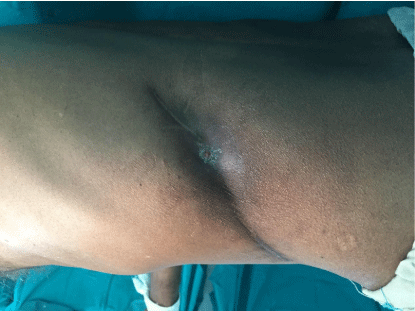
Case Presentation
Austin J Urol. 2019; 6(1): 1063.
Postnephrectomy Ureteral Stump Calculi: Cause of Ureterocutaneous Fistula
Gupta A* and Kumar Garg V
¹Department of Urology, Government Medical College and Hospital, India
²Department of Biochemistry, Government Medical College and Hospital, India
*Corresponding author: Vivek Kumar Garg, Department of Biochemistry, Government Medical College and Hospital, Chandigarh, 1600301, India
Received: September 18, 2019; Accepted: November 19, 2019; Published: November 26, 2019
Abstract
Among the various reasons for ureterocutaneous fistula including urological, gynecological, malignancy, trauma persistence of calculi in the ureteric stump following nephrectomy is rare cause. We have reported this case because of its rarity.
Keywords: Nephrectomy; Ureter; Calculus
Introduction
An urocutaneous fistula is abnormal communication between urinary tract and the skin. It may be from kidney, ureter, bladder or urethra. Chronic infection in the setting of calculi may be the cause of renocutaneous fistula [1]. Vesicocutaneous and ureterocutaneous fistula are mostly spontaneous or due to surgery and trauma. Here we report a case of uretrocutaneous fistula following nephrectomy as result of chronic infection due ureteric stump calculus (Figure 1).

Figure 1: Fistula with pus discharge at the previous incision scar site.
Case Report
60 year old male presented in our hospital with complain of discharge of pus from an opening in the incision scar on left posteriolateral aspect. Patient had underwent left nephrectomy two years back at a private hospital .Nephrectomy was done as the kidney was nonfunctioning as a result of obstructive uropathy caused by obstructive ureteric calculus. Physical examination revealed pus discharge from one end of incision scar (Figure 2). Urine routine showed 5-6 pus cells/hpf. Urine culture was sterile. His hemoglobin was 16 gm/ dl .Total counts were 16000. RFT and LFT were within normal limit.

Figure 2: Calculus impacted in the left ureteric stump (white arrow).
Ultrasound showed ill defined collection of 20x10mm about 3.5cm deep to superficial skin surface communicating externally. NCCT KUB showed absent left kidney with ill-defined collection in renal fossa with tract formation and a calculus of size 11x7mm in the proximal segment of left ureter.
MRI also showed similar findings.
Fistulectomy with left uretrectomy along with removal of ureteric calculus and debridement was performed successfully. Post-operative course was uneventful.
Discussion
Most ureterocutaneous fistulas are iatrogenic or surgically formed for urinary drainage. Other causes include penetrating trauma, malignancy and chronic infection. An uretrocutaneous fistula after nephrectomy is a rare complication and so far only a few cases have been reported [2-5]. Proper history and physical examination of the patient should be taken. Diagnosis is made through fistulography or CT scan (as in this case). Fistulogram shows the communication between the skin and the ureteric stump. Management includes surgical excision of the fistulous tract retrograde endoscopic injection of fibrin glue [6], urostomic exclusion using a covered wallstent [7] and saline rinse. Missed infected stone in the uretral stump was the cause of ureterocutaneous fistula. Thus our recommendation is to do nephroureterectomy along with the removal of infected stone to avoid such complication in future.
References
- Levi H. Primary spontaneous renocutaneous fistula. Urology. 1983: 22: 351.
- Vazquez AF, Vicente PFJ, Pascual GM, Funes PC, Cozar OJM, Talladauel BM. Ureterocutaneous fistula after nephrectomy: two cases. Actas Urol Esp, 2008; 32: 931-933.
- Shahidi S, fries J, Kay L. A ureterocutaneous fistula forty years after nephrectomy. Scand J Urol Nephrol, 2000; 34: 282-283.
- Chen Wen S, Nung Huang C, Fong Tsai Y, Jeng Wu W, Hsiung Huang C. Forgotten stone in a ureteral stump increased the risk of an ureterocutaneous fistula. Urological Science. 2012; 23: 96-97.
- Khalid, Singh M, Pankaj S, Tiwari R, Padhayay R, Choudhary V. Ureterocutaneous fistula with persisting stone in ureteral stump long time after nephrectomy. J of Evolution of Med and Dent. 2014; 3: 2278-4802,
- Sharma SK, Perry KT, Turk TM. Endoscopic injection of fibrin glue for the treatment of urinary-tract pathology. J Endourol. 2005; 19: 419e23.
- Cantwell CP, Lynch FC. Ureterocutaneous fistula and urostomy exclusion with use of a covered wallstent. J Vasc Interv Radiol. 2006; 17: 733e5.